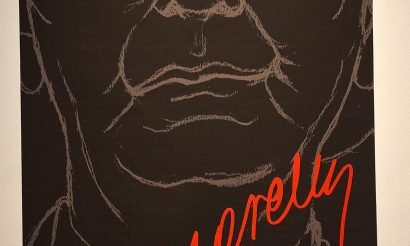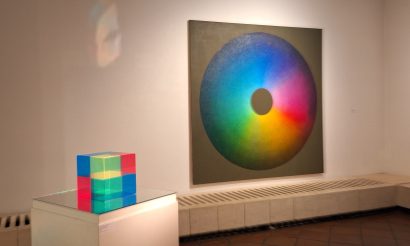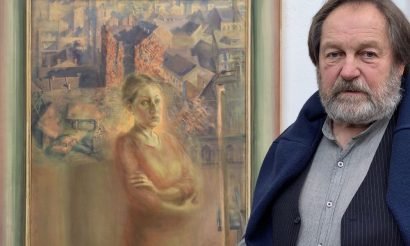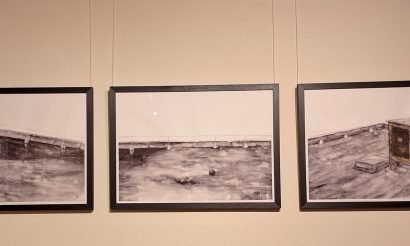KÃĐsÅn ÃĐbredtem
A vilÃĄg legifjabb ÃĐs legizgalmasabb, szÃĄzmilliÃģ dollÃĄros ÃĄrszintet elÃĐrÅ festÅje: Jean-Michel Basquiat, ÃĐlt huszonnyolc ÃĐvet, 1960-1988.
The worldâs youngest and most exciting painter, reaching a price level of hundreds of millions of dollars: Jean-Michel Basquiat, lived twenty-eight years, 1960-1988.
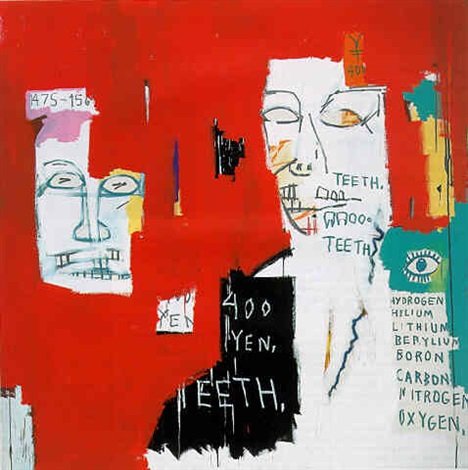
Jean-Michel Basquiat – Dos Cabezas 3 (1983) (2) ÂĐ Estate of Jean-Michel Basquiat. Licensed by Artestar, New York
Bizony kÃĐsÅn: most, hogy fenn van a vilÃĄgranglista ÃĐlÃĐn, mondanÃĄm az egekben, kapcsoltam. Martos GÃĄbor ugyan mÃĄr rÃĐg figyelmeztetett rÃĄ, hogy van itt egy zseni (Ilyet ÃĐn is tudok, 2017), de nekem akkor valahogy nem smakkolt a dolog. Most meg azt olvasom az FT-ben (Financial Timesban), hogy egyszerre kÃĐt helyen is, rÃĄadÃĄsul egyidÅben: 2021. mÃĄrcius 23-ÃĄn – lesz Basquiat-aukciÃģ: Hongkongban ÃĐs New Yorkban. Van annyi kÃĐpe? alkotÃĄsa? – kÃĐrdeztem magamtÃģl, hisz tudtam, hogy â88-ban elvitte a heroin, azaz huszonnyolc ÃĐvesen, ifjÚsÃĄga teljÃĐbenâĶ (A zsenik korÃĄn halnak meg.) KisÞlt, hogy van annyi kÃĐpe. (A hagyatÃĐk ÅrzÅi kb. 117 festmÃĐnyt, ezernyi grafikÃĄt stb. Åriznek.) LegdrÃĄgÃĄbb festmÃĐnye 110.5 milliÃģ volt, (Sothebyâs aukciÃģn, 2017-ben, egy japÃĄn milliÃĄrdos vette meg). AzÃģta is mennek fel az ÃĄrai, $40-50 millÃĄnÃĄl alÃĄbb nem adja.
Nem a divat lendÃtett rajta, festÅkÃĐnt igazi, eredeti nagysÃĄg lett. KÃķzben az elmÚlt pÃĄr ÃĐv alatt beleszerettem, kb. Úgy, ahogy a zenÃĐben NatÃĄlia Lisitsa zongorajÃĄtÃĐkÃĄba. (Minden este megy egy-kÃĐt Beethoven-szonÃĄta vagy Rachmaninov zongoraversenyâĶ) Persze Basquiat mÃĄs tÃĐszta, mÃĄskÃĐpp kell szeretni, aminek esztÃĐtikai elemzÃĐsÃĐbe nem megyek bele, mivel csak vendÃĐgszereplÅ vagyok a mÅąvÃĐszettÃķrtÃĐnetben, ÃĐs ennek a HaitibÅl New Yorkba repÞlt zseninek a nyelve is ÃĄllandÃģan vÃĄltozik, nehÃĐz kÃķvetni, megfejteni, befogadni.
Ennek ellenÃĐre, vagy ÃĐpp ezÃĐrt: nagy ÃĐlvezet, mÃĄr az is, ahogy mÃĄszok utÃĄna. ÃllÃtÃģlag megszÃķkÃķtt otthonrÃģl, gimnÃĄziumba hol jÃĄrt, hol kihagyta, valami kÃĐpzÅmÅąvÃĐszetit viszont vÃĐgigjÃĄrta. Cy Twomby-t ÃĐs Andy Warholt tekintette mentorÃĄnak, ez utÃģbbival barÃĄtsÃĄgba is kerÞlt, az meg felismerte benne a zsenit ÃĐs egyengette ÚtjÃĄt. AztÃĄn elÅbb nyomor, majd pince, aztÃĄn az East Village-en valami stÚdiÃģfÃĐlesÃĐg kÃķvetkezett. Az East Village-ban az avantgÃĄrd legjobbjai fordultak meg, zene, regÃĐny, koksz ÃĐs zsenialitÃĄs keverÃĐkÃĐvel elegyÃtve ezt a mÅąvÃĐszi âtelephelyetâ. Basquiat kezdetben street art (graffitik falrafÚjÃĄsÃĄval szÃģrakozott), grafikÃĄit papÃrra rÃķgzÃtette, de volt zenekara is, de ezt most hagyom, mert nem ÃĐrtek hozzÃĄ.
Egy Mudd Club nevÅą, manhattani night club, avantgÃĄrd talÃĄlkahely vezetÅje Diego Cortez balhÃĐbÅl meghÃvta egy bemutatÃģra, ÃĄm ezzel kivÃĄgÃģdott az ajtÃģ, cikk jelent meg rÃģla az Art in AmerikÃĄban, majd a NY Times-ben, ÃĐs terjedt a hÃre. ElsÅ kiÃĄllÃtÃĄsa 1980-ban volt, ott figyelt fel rÃĄ a hÃres galerista, mÅąkereskedÅ Jeffrey Deitch, ÃĐs aztÃĄn jÃķttek a kiÃĄllÃtÃĄsok dÃķgivel. Sietni kellett, mert a kaszÃĄs mÃĄr fÃĐlÚton volt felÃĐ. Ez alatt a hÃĐt ÃĐv alatt âcsinÃĄlta meg magÃĄtâ, illetve a mÃĐdia, a tÃĐvÃĐ, a street art, meg a fehÃĐr mÅąvÃĐszbrancstÃģl elÞtÅ, ritkasÃĄg: szÃnes bÅrÅąkÃĐnt beverekedte magÃĄt az elitbe.
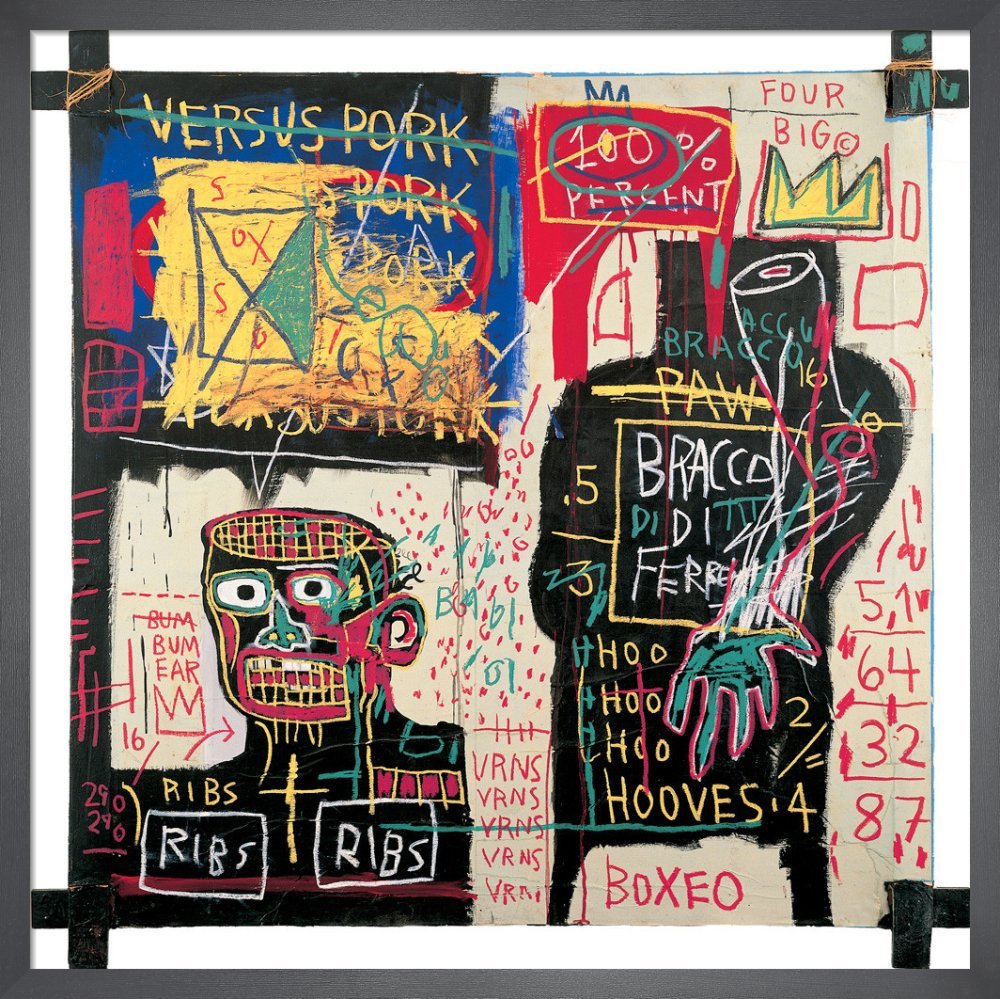
Basquiat – The Italian Version of Popeye has no Pork in his Diet ÂĐ Estate of Jean-Michel Basquiat. Licensed by Artestar, New York
Amit csinÃĄlt, szerintem nem besorolhatÃģ, (neoexpresszionizmusnak szokÃĄs nevezni a stÃlusÃĄt, de gondolom, csak jobb hÃjÃĄnâĶ). BarbÃĄr, nyitott, absztrakt ÃĐs egyben figurÃĄlis (hogy hogyan, azt ne kÃĐrdezdâĶ); minden kÃĐpe mÃĄs, bÃĄr vad dinamikÃĄja mindig felismerhetÅ. Emellett grafikus eredetÃĐt sem tagadja meg, kÃĐpein a vonal/szÃn ÃĐs tÃĐmabeli dinamika tÃĄnca uralkodik, ÃĄm kÃķzben mÃĐgis a vonalas ÅrÞlet tombol bennÞk. De nemcsak ezt a technikai rÃĐszletet kell megemlÃtenem, hanem azt a gesztust is, hogy az elnyomott szÃnes kisebbsÃĐgek ilyen-olyan kÃĐpvariÃĄciÃģi megjelennek festmÃĐnyein. EzenkÃvÞl minden festmÃĐnye valamilyen lÃĄzadÃĄs a korÃĄbbi, absztrakt expresszionizmus (Pollock, vagy akÃĄr Rothko) korszaka, kÃĐpkoncepciÃģja ellen. A âkÃvÞlrÅl ÃĐrkezettekâ lÃĄzadÃĄsaâ adja kÃĐpeinek dinamikÃĄjÃĄt. De nem mernÃĐm a tovÃĄbbiakban elemezni festmÃĐnyeit, inkÃĄbb fiatalsÃĄgÃĄt csodÃĄlom, nem csodagyerek volt, hanem ÃķnkÃĐpzÅ gÃĐniusz.
MÅąveit jelenleg â ha jÃģl tudom â a Basquiat Estate (hagyatÃĐk) kezeli a festÅ hÚgai irÃĄnyÃtÃĄsÃĄval, korÃĄbban ugyanezt a munkÃĄt apja, Gerard Basquiat vÃĐgezte, 2013-ban bekÃķvetkezett halÃĄlÃĄig. A Christieâs, a Sothebyâs ÃĐs a tÃķbbi aukciÃģs hÃĄz verekszik mÅąviÃĐrt. MÅąÃĐrtÅk ÃĐs milliomosok tolonganak, ha nyÃlik valahol (mondjuk a Tate-galÃĐriÃĄban) kiÃĄllÃtÃĄsa. Mit mondjak, modern csoda.
I woke up late
Jean-Michel Basquiat
The worldâs youngest and most exciting painter, reaching a price level of hundreds of millions of dollars: Jean-Michel Basquiat, lived twenty-eight years, 1960-1988.
Indeed, it is too late: now that he is at the top of the world rankings, I would say in heaven, it has clicked for me. Although GÃĄbor Martos has long warned us that there is a genius here (ILYET ÃN IS TUDOK, 2017), I somehow didn’t vibe with it back then. Now, I read in the FT (Financial Times) that in two places at once, at the same time: March 23, 2021 – there will be a Basquiat auction: in Hong Kong and New York. Does he even have this many pictures, creations? I asked myself, knowing that he was taken by heroin in â88, that is, at the age of twenty-eight, at the peak of his youthâĶ (Geniuses die early.) It turns out that he had so many pictures. (The custodians of his legacy have preserved about 117 paintings, thousands of graphics, etc.) His most expensive painting was worth 110.5 million US dollars, (bought at a Sothebyâs auction in 2017 by a Japanese billionaire). Since then, the prices of his pictures have been going up, not dropping below $ 40-50 million dollars.
It wasn’t the trends that gave him a leg up, as a painter he became a real, original greatness on his own. In the meantime, Iâve fallen in love with his work over the last few years, similar in way as I did in music with Natalia Lisitsaâs piano playing. (Every night there are one or two Beethoven sonatas or Rachmaninov’s piano concertosâĶ) Of course, Basquiat is a horse of another colour. I have to love his work in a different way, which I don’t go into an aesthetic analysis of, as I’m just a guest in the field of art history, and the language of this genius who came from Haiti to New York, constantly changes, is difficult to follow, decipher and accept.

Jean-Michel Basquiat – Dos Cabezas 3 (1983) (2) ÂĐ Estate of Jean-Michel Basquiat. Licensed by Artestar, New York
Still, or maybe for this exact reason: I find great pleasure, even in trying to catch up with him. He allegedly escaped from home, went to high school here and there, but finished a school of fine arts. He considered Cy Twomby and Andy Warhol his mentors, the latter also befriended Basquiat, recognized the genius in him and helped him along his way. Then there came misery in his life, then a cellar and then some kind of a studio in East Village. In the East Village, the best of the avant-garde hung around, blending this artistic âsiteâ with a mix of music, novel, coke and genius.
Basquiat initially did street art (he had fun blowing graffiti on the walls), had his graphics on paper and he also had a band, but Iâll leave that for now because itâs not my area of expertise.
Diego Cortez, the manager of an avant-garde meeting place called Mudd Club, a Manhattan nightclub, invited him just to stir things up a little, but it made the doors bust open, resulting in an article about him in Art in America, then in the NY Times, and word started to spread about him. His first exhibition was in 1980, where he was noticed by the famous gallerist and art dealer Jeffrey Deitch, and then the exhibitions started rolling in. He had to hurry because the reaper was already halfway there. During these seven years, he really âmade himselfâ, a rare phenomenon that contrasted with the media, television, street art, and the white artist brunch: he became a member of the elite as a person of colour.
What he did, in my opinion, cannot be classified, (his style is usually called neo-expressionism, but I think only for lack of a better oneâĶ). Raw, open, abstract and at the same time figural (don’t even ask, how is it possibleâĶ); each of his images are different, though his wild dynamics are always recognizable. He also doesn’t deny his origins as a graphic artist, as his paintings are dominated by the dance of line / color and thematic dynamics, while in the meantime, the line-madness is raging in them.
I have to also mention not only this technical detail, but also the gesture that the image variations of oppressed colored minorities appear in his paintings in different ways. In addition, each of his paintings is a kind of rebellion against the era of the earlier abstract expressionism (Pollock, or even Rothko). The ârebellionâ of âthe outsidersâ is what gives the dynamics to his pictures. But I wouldnât dare to analyze his paintings any further, Iâd much rather admire his youth, he wasnât a prodigy, but a self-educating genius.

Basquiat – The Italian Version of Popeye has no Pork in his Diet ÂĐ Estate of Jean-Michel Basquiat. Licensed by Artestar, New York
His works are currently, as far as I know, are managed by the Basquiat Estate (legacy) under the direction of the painterâs sisters, previously the same work was done by his father, Gerard Basquiat, until his death in 2013. Christieâs, Sothebyâs and other auction houses are fighting for his artwork. Connoisseurs and millionaires are flocking to his exhibitions when they open somewhere (say in the Tate Gallery). What can I say, a modern marvel.
MiklÃģs AlmÃĄsi

